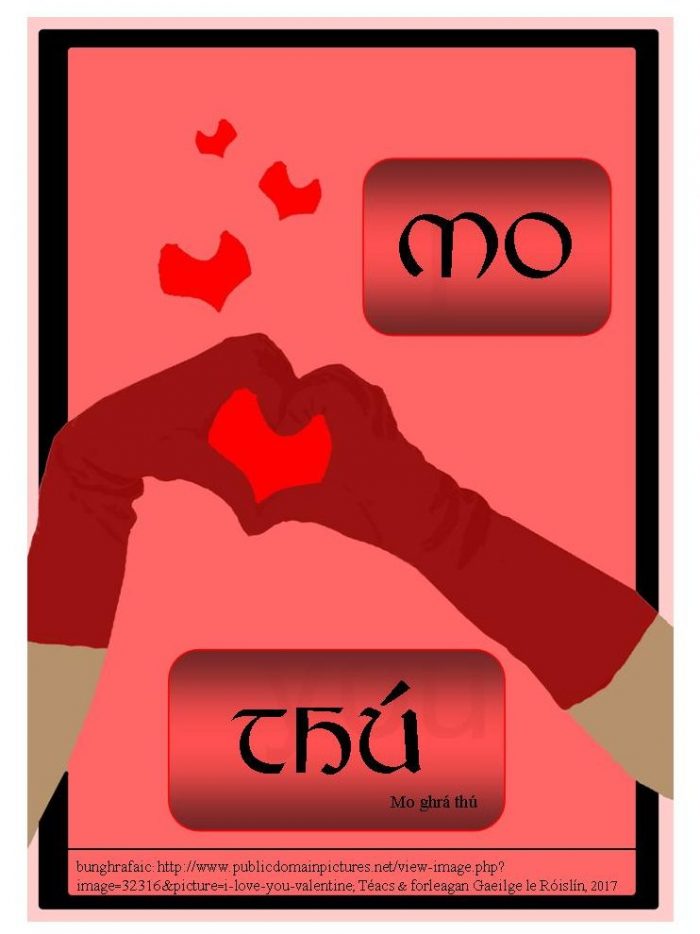More Practice with Saying Who Loves Whom in Irish — in am do Lá Fhéile Vailintín Posted by róislín on Feb 6, 2017 in Irish Language
(le Róislín)
Last year around this time, we looked at ten different ways to say you love someone, with blanks to fill in to complete the sentences, sometimes just a missing letter, sometimes a full word (nasc thíos).
This time we’ll revisit some of those phrases, with a few variations, but with different blanks to fill in, so you’ll have a dúshlán difriúil. In these sentences, most of the unpredictable sounds will be the lenited ones, i.e. those spelled with an added “h” after the first letter (like “a ghrá” or “a mhuirnín“). Of course, if you have “seanchleachtadh” with Irish, these will be nothing new, since you’ve probably already practiced words in direct address, like “a Ghráinne” (if speaking directly to Gráinne) or “a Mhaidhc” (if speaking directly to Maidhc, that is, “Mike”).
The translations will be given below, with the answers, comments, and a few pronunciation notes, especially for the less predictable sounds.
- Is tú ___o stór
- Is tú mo stóir___n
- Is tú mo g___rá
- Is tú mo c___uisle
- Is tú mo m___uirnín
- Is ___ grá geal mo c___roí 6b. Is í grá geal mo c___roí ___,
- Mo g___rá t___ú!
- Tá grá aga___ duit. 8b. Tá grá aga___ ort
8c. Tá grá ai___e uirthi. 8d. Tá grá ai___i air.
- 9a. Táim i ___grá leat 9b. An bhfuil tú i ___grá lio___?
9c. Tá sé i ___grá lé___, 9d. Tá sí i ___grá le___s.
9e. Tá Mickey Mouse i ___grá l___ Minnie Mouse
9f. Tá Addison i ___grá l___ Madison.
- Tá mo c___roí istigh iona___,
That’s a sample, anyway, mostly practicing lenition, prepositions, and pronouns. Tá súil agam gur breá leat cleachtaí mar sin (I hope you love exercises like that). To say you love something like a food or a movie or, in my case, grammar, the combination “breá” + “le” is often used (Is breá léi é. Deir sí gur breá léi é, srl. — translating “é” as “it” here; Is breá léi seacláid) — SGF – Róislín
Nasc: Saying “I Love You” in IrishPosted by róislín on Feb 11, 2016 in Irish Language
Freagraí agus aistriúcháin. “Sweetheart” or “beloved” or some other term of endearment could also be used in many of these. .
- Is tú mo stór, you are my darling.
- Is tú mo stóirín, you are my little darling (more affectionate than diminutive as such)
- Is tú mo ghrá, you are my love
- Is tú mo chuisle [KHUSH-luh], you are my pulse. You might recognize this one from the anglicization “Macushla.” The basic word for “pulse” is “cuisle.”
- Is tú mo mhuirnín [WURzh-neen OR VURzh-neen], You are my darling. You might recognize this one from the song “Kathleen Mavourneen,” since “Mavourneen” is really “mo mhuirnín.”
6a. Is tú grá geal mo chroí [khree], You are the bright love of my heart.
6b. Is í grá geal mo chroí í, She is the bright love of my heart.
- Mo ghrá thú!, You (are) my love! Very literally: My love you (are). Used a lot for “I love you!” There’s no actual verb in this Irish phrase, which seems to be the most commonly used of all of the expressions for romantic love, said directly to the beloved.
- 8a. Tá grá agam duit, I love you, lit. Love is at me for you.
8b. Tá grá agam ort, I love you, lit. Love is at me on you.
8c. Tá grá aige uirthi, He loves her, lit. Love is at him on her.
8d. Tá grá aici air, She loves him, lit. Love is at her on him.
9a. Táim i ngrá leat, I am in love with you. To pronounce the initial “ng-“, think of it as being attached to the preceding “i,” so it’s like the “-ng-” of “singing” (not like the “ng” of “finger”).
9b. An bhfuil tú i ngrá liom? Do you love me?
9c. Tá sé i ngrá léi, He is in love with her.
9d. Tá sí i ngrá leis. She is in love with him.
9c. Tá Mickey Mouse i ngrá le Minnie Mouse, Mickey Mouse is in love with Minnie Mouse.
9f. Tá Addison i ngrá le Madison. Addison is in love with Madison.
- Tá mo chroí istigh ionat, I love you, lit. My heart is in you, or, even more literally, My heart is inside in
Of course, you could always say, “Tá mo chroí istigh ionam,” if you really wanted to make that point (My heart is inside me). That would most likely be said by a folkloric figure like Bata in the ancient Egyptian Tale of the Two Brothers, whose heart is placed in a flower pot for safe-keeping (it’s folklore!), or in a modern echo of the same theme, Tubba Blubba in the video game Paper Mario. That “Bata,” btw, is completely different from the Irish word “bata” (a stick).
Another “person” who might have reason to make a similar statement would be the Doctor, from Doctor Who. He has two hearts, so his point would be to say, “Tá dhá chroí istigh ionam” (Two hearts are inside me). Dá mba rud é go raibh Gaeilge aige! ‘S b’fhéidir go bhfuil. Cá bhfios dúinn?

Build vocabulary, practice pronunciation, and more with Transparent Language Online. Available anytime, anywhere, on any device.





Leave a comment: